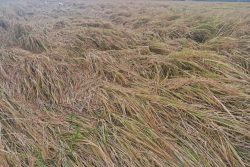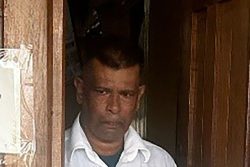With the price for paddy remaining below $3,000 per bag for the past two years, President of the Rice Producers’ Association (RPA) Leekha Rambrich says less land is being planted and more farmers are “falling out” of the industry.
Rambrich told Stabroek News in an interview last week that there has been a “decline in cultivation, crop after crop, from 2015 to now and this is becoming a worrisome situation, especially for the milling association.”
Some of the small farmers from Leguan, who have had to hire combines and tractors to undertake the work in the fields, have opted to rent their lands.
They told this newspaper that they are depending on the rental fees or have turned to cash crops and provision farming to sustain their families.
According to Rambrich, many farmers in Berbice have abandoned their lands and migrated. He said some farmers have decided to stay and invest, despite facing various setbacks, “because they have the land and don’t have any other means of earning an income.”
Scaling down
Mohamed Ramzan, of Success Village, Leguan has scaled down his cultivation from 65 acres to 40 acres because it is not worth the investment.
He pointed out that last crop the millers paid $2,100 for each 170-pound bag of paddy. Even though he was not at all satisfied, it was a little better than what he earned previously, when they paid the same price for a 180-pound bag.
He believes that the millers took less weight for the same price “because the competition is on,” with some farmers taking their “paddy to mills on the West Coast.”
As he is now cultivating the new crop, he has already experienced an increase in the price of diesel, which has moved from $3,700 per drum during the last crop to $3,900 this crop. He also said the prices for urea fertiliser ranged from $4,200 per bag to $6,500 during the last crop and while he has not purchased any as yet for this crop, he is hoping that he would not have to pay more.
Doodnauth Ramsew, another farmer, of Bengal, Corentyne, who invested in equipment to get into large-scale rice farming, has also had to scale down cultivation from the 350 acres to about 275 acres.
However, unlike the other farmers, he rents most of the land. He said his investment means that quitting is not an option for him and even though the paddy price is low, he expected that he would “still make something.”
Ramsew started the business seven years ago but was not able to cultivate about three crops because of poor drainage and irrigation.
According to him, he cannot get access to water because the canal close to his fields had not been dug for some time and was filled with silt and overgrown with vegetation.
He met with officials from the Regional Democratic Council and the village office and they promised to clear the canal but have not done so. He said he was disappointed that the excavators would “pass me [his fields] and go down and dig the canals at the back….”
Ramsew explained too that he is the only rice farmer whose fields are close to the canal but added regardless of that, he is a taxpayer and should enjoy the same benefits as the others.
Ramsew could not wait any longer and has decided to rely on the mercy of the rain to go through with this crop. In the meantime, he has been planting tomatoes to earn an income to sustain his family.
‘Pressure’
Meanwhile, Rambrich said “the profit margin is very thin and if farmers lose one crop, it is a big setback.” As a result, he called on government to strengthen the drainage and irrigation system, which is a constant problem.
He hoped that the “government would use the opportunity to service the pumps while the rain is falling and supply enough water for farmers. When farmers need water the pumps are not in order.”
Another issue affecting the farmers is the $15,000 rental fee per acre that the government is now charging in some areas. “That’s why the industry is falling; farmers cannot stand to the pressure. Most people migrating!” he said.
Rambrich also pointed out that “millers are foreseeing that if the industry is sliding downwards there would be very little paddy for the mills.”
He believes that it is time to make recommendations to the government to “import some high yielding variety” of rice so as to improve the state of the industry.
“This would benefit the farmers a lot and even if less land is cultivated, farmers can maintain productivity,” he said.
According to Rambrich, the RPA will meet with the Guyana Rice Development Board to put that proposal to the government.
Rambrich said that with no increase in the price for paddy, farmers in Region Six are earning $40,000 to $42,000 per tonne.
In Region Five, where there is a high demand due to the presence of more mills, the price ranges from $40,000 to $44,000 per tonne, while in regions Two and Three, it ranges from $35,000 to $40,000 per tonne.
Rambrich said that 98 percent of harvesting for the last crop has been completed, with the remaining two percent being in regions Five, Six and Two.
The cultivation for the next crop has commenced and he is anticipating a smaller crop because of the early rainfall. This would cause some setback because the fields that have not been harvested early would be affected.
He told this newspaper that when the crops are good, farmers can produce some 440,000 tonnes of paddy per year.
Out of that amount, only 40,000 tonnes is consumed locally, with the remaining 400,000 tonnes being exported to markets in the Caribbean, Europe, Asia and Central America.
With regard to the Mexican market that Prime Minister Moses Nagamootoo was trying to source for the sale of paddy, Rambrich believes “that is dead… We cannot compete with the US, so I don’t think that would work out.”







